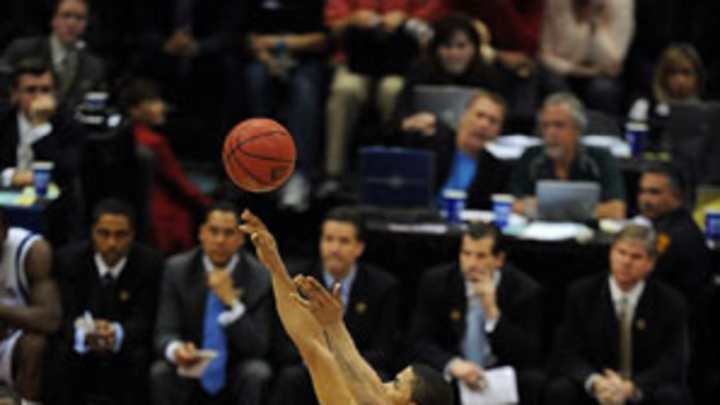Mythbusters: Hit your free throws


We all remember the NCAA tournament championship game last season when, in the final minute and 15 seconds, Memphis missed four of its last five free throws to lose to Kansas 75-68 in overtime. That one game validated the complete coaching philosophy of every (otherwise supportive) father who has ever sat in the bleachers at his son's high school basketball games and screamed, "Hit your d--- free throws, Jacob Edward Osterhout!"
My dad, a former basketball player himself, was a maniac at my high school games, constantly screaming out instructions from his seat in the crowd. For him, the most important part of the game was fundamentals, and the most important fundamental was making free throws.
But was my dad right? Does a basketball team really have to shoot the lights out from the foul line to be successful? True, if Memphis had just hit one more free throw during regulation in that final game last season, the Tigers wouldn't have lost to Kansas. Of course, the same could be said for Memphis' perimeter defense (how did you let Mario Chalmers get a clean look at the basket?), but you don't hear anyone saying, "See, you've got to cover the three if you want to win a championship."
So, with the NCAA Tournament back in full swing, and my old man once again savagely screaming at his TV set, it seems like an appropriate time to finally debunk my father's myth of the free throw. Listen up, Pops: a basketball team that shoots mediocre free throws can not only make the NCAA Tournament, but win the whole kit and kaboodle.
Before I start down this path, it's important to point out that making free throws allows a team to score more points, which certainly improves its chances of winning. That is not what I am arguing here. What I am arguing is that college basketball teams don't necessarily have to consistently hit their free throws to be successful.
Let's take a look at the 16 teams left in the NCAA Tournament this season. Only seven teams shoot better than 70 percent from the foul line, and of those seven, only one, North Carolina, which shoots 76.4 percent from the stripe, is a No. 1 seed. The other three No. 1 seeds -- Pittsburgh, Louisville and Connecticut -- all hit less than 68 percent of their foul shots. That's below the league average since the mid-1960s, according to the New York Times.
Meanwhile, teams that enter the tournament with high free-throw shooting percentages have been knocked off. Utah came in with the highest percentage (78.1) but the Utes lost to Arizona (73.9) in the first round. Maryland, California, Northern Iowa, Michigan, Utah State, North Dakota State and Oklahoma State were among the top 30 Division I teams in free throw shooting, and all bowed out in the first two rounds. Of the remaining 16 teams, only Villanova, North Carolina and Arizona are among the top30 free-throwing shooting teams
The past two national champions were fundamentally sound from the line. Kansas made 70.2 of its foul shots, and Florida maintained a 69-percent average. (Side note: way back in 2004, Connecticut won the title while shooting a mere 62.3 percent from the line.)
What's interesting is that while neither Kansas nor Florida shot free throws very well during their championship seasons, both teams went to the foul line a lot. The Jayhawks had the 132nd best free throw percentage in college basketball, but they also shot the 11th most free throws in the nation. The same pattern holds true for the Gators, who were 173rd in the nation in free throw percentage while taking the fourth most trips to the line. (Addendum to the side note: The Huskies were 312th in the nation in free-throw percentage, but they went to the stripe the eighth most times of any team that season.)
Statistically speaking, it seems much less important for a winning team to make its free throws than to just get to the line. In this year's Sweet 16, only 33 percent of the teams maintain a percentage to land them among top 100 nationally, but nearly 75 percent of them are in the top 100 for number of foul shots attempted. Which leads to the conclusion that the way to overcome poor free throw shooting is to shoot more free throws.
So, my dad and all those other basketball coaches that preached the importance of making free throws were misguided. Winners don't necessarily make their foul shots -- they just get to the foul line. Instead of yelling at me to "make my d--- free throws," my father should have just been happy I was at the line to begin with. Besides, do you know how hard it is to concentrate on the front end of a one-and-one when your old man is screaming vulgarities at you from the bleachers? No pressure, young man. No pressure at all.
Sweet 16 Free Throw Percentages
1. UNC 76.42. Villanova 74.63. Arizona 73.94. Duke 72.85. Kansas 72.36. Gonzaga 71.87. Purdue 70.68. Memphis 69.59. Michigan State 69.110. UConn 67.711. Oklahoma 67.712. Pitt 67.513. Xavier 67.414. Mizzou 67.415. Syracuse 64.416. Louisville 63.8
